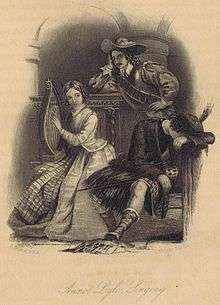A Legend of Montrose
| Author | Sir Walter Scott |
|---|---|
| Country | Scotland |
| Language | English, Lowland Scots |
| Series | Tales of My Landlord (3rd series) |
| Genre | Historical novel |
| Publisher | Constable & Co Ltd |
Publication date | 1819 |
| Media type | Print (Hardback & Paperback) |
A Legend of Montrose is an historical novel by Sir Walter Scott, set in Scotland in the 1640s during the English Civil War. It forms, along with The Bride of Lammermoor, the 3rd series of Scott's Tales of My Landlord. The two novels were published together in 1819.[1]
Plot summary
The story takes place during the Earl of Montrose's 1644-5 military campaign in Scotland on behalf of King Charles I against the Covenanters who had sided with the English Parliament in the English Civil War.
Earl of Montrose

The main plot concerns a love triangle between Allan M'Aulay, his friend the Earl of Menteith, and Annot Lyle. Annot is a young woman who has been brought up by the M'Aulays since being captured as a girl during a blood feud against the MacEagh clan (also known as the Children of the Mist). M'Aulay and Menteith are both members of Montrose's army. Annot eventually marries Menteith after it is discovered that she has aristocratic blood, and was kidnapped by the MacEaghs as a baby. This leads to the jealous M'Aulay stabbing Menteith and then fleeing Montrose's army. Menteith survives whilst M'Aulay disappears and is rumoured to have been killed by the MacEaghs.
Dalgetty
Much of the novel is taken up with a subplot involving an expedition into enemy territory by Dugald Dalgetty, an experienced mercenary fighting for Montrose. Dalgetty does not fight out of political or religious conviction, but purely for the love of carnage. However, he is very professional, and remains loyal to an employer to the end of his contract. He gained his experience fighting for various armies during the Thirty Years' War, then still raging in Germany. Note: He did not fight all thirty years. Dalgetty is regarded as one of Scott's finest comic characters, however he dominates so much of the story that the main plot is not really developed in detail.
Sources and inspiration

Dugald Dalgetty is based upon James Turner and Robert Monro, 17th century soldiers.[2] Dalgetty's name is derived from Captain Delgatty of Prestonpans, an acquaintance of Scott. Menteith is based upon John Graham, Lord Kilpoint (1613-1644). Evan Dhu represents Ewen Cameron of Lochiel (1629-1719). James Graham, 1st Marquis of Montrose (1612-1650) who led the 1644-5 military campaign described in the novel, also appears as a character.[3]
Several parts of the novel are influenced by traditions concerning the Stewarts of Ardvorlich, specifically James Stewart of Ardvorlich.[4] The novel's castle of Darnlinvarach is commonly said to represent Ardvorlich House. The latter actually appears in the novel as the castle of Ardenvohr, which may be somewhat based upon Dunstaffnage Castle.[3]
The following story of murder provided inspiration.[5] In the Seventeenth Century it was the custom to provide hospitality to anyone who asked for food and shelter. If the guest was not a friend, they were still put up, but instead of a cooked meal were given cold meat (this is where the phrase "given the cold shoulder" comes from). In accordance with this custom, Lady Margaret Stewart at Ardvorlich, pregnant at the time, gave hospitality to some travelling MacGregors. However, they had just come from murdering her brother, John Drummond of Drummonderinoch, and while she was out of the room placed his severed head on a silver platter, and placed in his mouth some of the cold victuals she had served them. She was so distraught that she ran out to the hills and gave birth to James Stewart, later known as the "Mad Major".[6] The Loch she gave birth by is now known as Lochan na Mna, the Loch of the Woman, on the side of Beinn Domhnuill.
Major James Stewart is one of the great historical characters of the Covenanting Wars and was the inspiration for Allan M'Aulay. This name is actually engraved on the foot of Major Stewart's gravestone in the Stewarts of Ardvorlich old kirk of Dundurn just outside the village of St Fillans on the shores of Loch Earn.[7]
External links
- A Legend of Montrose at Project Gutenberg
- A Legend of Montrose at The Walter Scott Digital Archive, Edinburgh University Library

References
- ↑ "A Legend of Montrose". Edinburgh University Library. Retrieved 28 April 2018.
- ↑ Brockington, William S. (2001), "Robert Monro: professional soldier, military historian and Scotsman", in Murdoch, Steve, Scotland and the Thirty Years' War, 1618-1648, Brill, p. 215 fn 3, ISBN 90-04-12086-6 . See also: Scott, Walter (1995), Alexander, John Huston, ed., A legend of the wars of Montrose, Edinburgh University Press, p. 223, ISBN 9780748605729 .
- 1 2 Scott, Walter (1995), Alexander, John Huston, ed., A legend of the wars of Montrose, Edinburgh University Press, p. 223, ISBN 9780748605729 .
- ↑ Scott, Walter (1995), Alexander, John Huston, ed., A legend of the wars of Montrose, Edinburgh University Press, pp. 221–222, ISBN 9780748605729 . See also: Moncreiffe of that Ilk, Iain (1967), The Highland clans, Bramhall House, p. 54 .
- ↑ Stewart, Walter (1902). Waverley Novels: A Legend of Montrose. Edinburgh: Constable. p. xiv. Retrieved 14 January 2017.
- ↑ Hendrie, William F. (2004). The Trossachs: History and Guide. Stroud: Tempus. p. 36. ISBN 9780752429915.
- ↑ Balquhidder Stewart webpage Retrieved November 2010